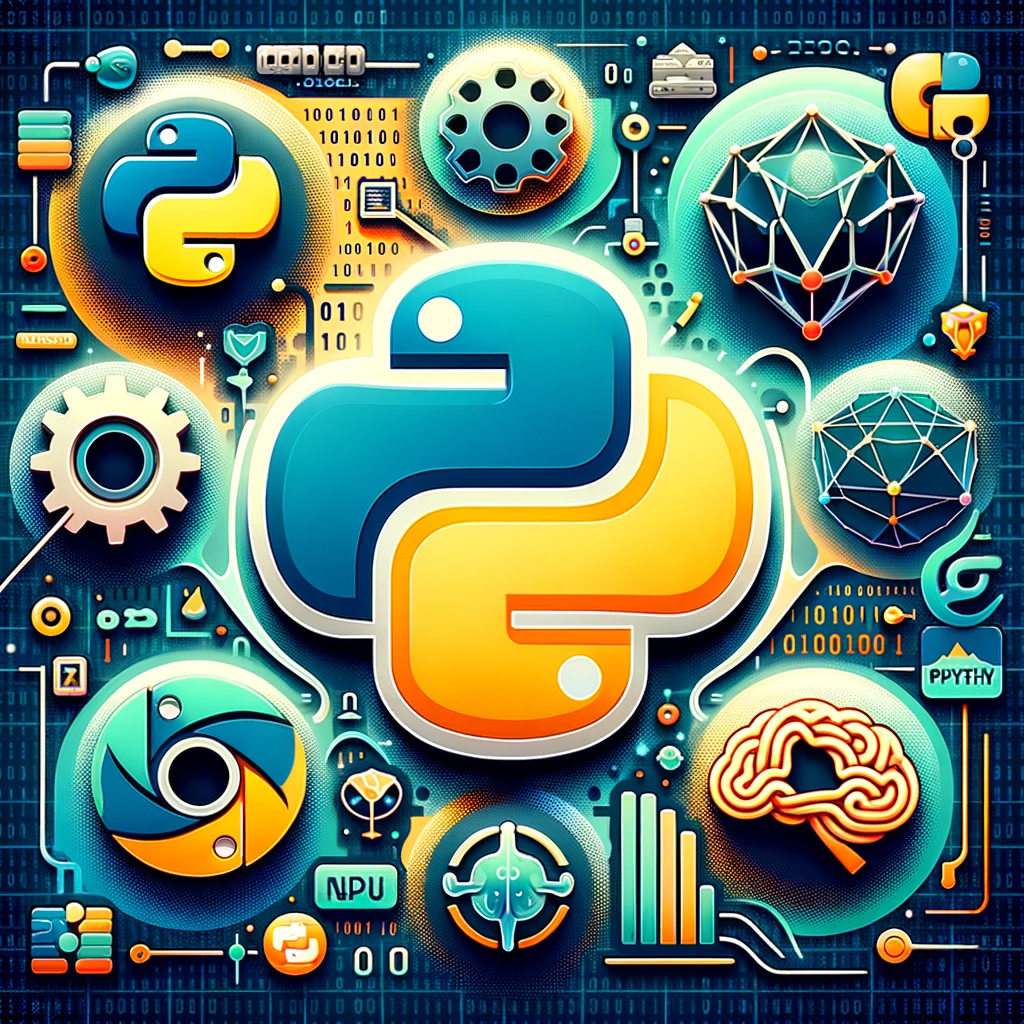Data technology is evolving rapidly, and Python libraries for Data Science and Information technology are still leading the way because the portable language for statistics enthusiasts is international Because of its versatility and large libraries like NumPy, Pandas, Matplotlib, SciPy, Scikit-research, Keras, TensorFlow, Statsmodels, Seaborn, and NLTK. Python provides facts scientists can generate valuable insights from complex datasets. In this issue, we will see some of the top Python libraries that every information enthusiast should have in their toolkit.

1. NumPy Python Library: Unleash the power of numeric calculations
NumPy, short for Numerical Python, is an essential library for scientific calculations in Python. It provides instructions for powerful multidimensional arrays and matrices, as well as a combination of mathematical power to work efficiently on these arrays. Using NumPy, performing mathematical and logical operations on arrays becomes easier, making it an important tool for data processing and analysis.
2. Pandas Python library: Data arguments made it easier
The Pandas Python Library is intuitive and user-friendly which simplifies statistical manipulation and analysis tasks. It provides efficient record structures such as DataFrame and Series, which allow easier management of the data it depends on. Whether it’s cleaning up cluttered data sets, manipulating statistics, or tweaking statistical analysis, Panda simplifies the entire process. Its simple syntax and elegant capabilities make it a must-have for every accountant.
3. Matplotlib Python Library: Visualize Your Data with Ease
Visualization is key to knowing how complex datasets are, and Matplotlib Python Library excels in this area. As a 2D plotting library, Matplotlib allows information scientists to create static, interactive, and animated visualizations with ease. From easy line plots to sophisticated heatmaps, Matplotlib offers a huge range of plotting capabilities to convey insights efficaciously. With customizable capabilities and extensive documentation, Matplotlib empowers statistics lovers to create compelling visible narratives quickly.
4. SciPy Python Library: Accelerate Scientific Computing
SciPy Python Library builds upon the muse laid by NumPy and provides additional capability for medical computing. It offers a massive array of numerical workouts for optimization, integration, interpolation, and more. Whether it is solving differential equations or appearing in statistical evaluation, SciPy provides efficient and sturdy algorithms to address complex troubles. Its integration with other Python libraries makes it a valuable asset for information scientists working on diverse initiatives.
5. Scikit-research: Machine Learning Made Accessible
Machine-gaining knowledge lies at the heart of modern-day data technology, and the Scikit-learn Python library makes it on hand to all. This comprehensive library gives efficient tools for information mining and facts analysis, with a focal point on system mastering algorithms. Scikit-learn covers an extensive range of device mastering tasks from type and regression to clustering and dimensionality discount. With its easy and consistent API, statistics fanatics can quickly prototype and deploy systems getting to know fashions for actual-global applications.
6. TensorFlow Python Library: Unleash the power of deep learning
Deep knowledge acquisition has revolutionized artificial intelligence, and TensorFlow Python library is at the forefront of this revolution. Developed with the help of Google Brain, TensorFlow is an open-supply deep mastering framework that offers incredible flexibility and scalability. It enables virtual reality scientists to build and train deep neural networks, including image naming, herbal language processing, etc. With an overwhelming API and efficient distributed computing, TensorFlow empowers virtual reality enthusiasts to push the boundaries of innovation in data technology
7. Keras: Facilitating deep learning
Keras is a hyper-staged neural network API, written in Python and running on top of TensorFlow, Theano, or CNTK. It allows for faster and faster deep tissue testing. Keras boasts of a user-pleasant interface, which makes it easy for newbies and also one that is still effective enough for better learning. On Keras, statistical catalysts can quickly build and deploy deep detection models, focusing more on architecture and less on processing information
8. Stats Models: Simplified statistical models
For information scientists who need better statistical analysis, Statsmodels is a cross-to library. It offers a wide variety of mathematical fashions and tests considering thorough mathematical analysis. Whether it is linear regression, cumulative time analysis, or hypothesis testing, Statsmodels provides powerful and reliable methods for statistical and predictive data science workflow, empowering users to gain deeper insights into their datasets.
9. Seaborn Python Library: Enhance Your Visualizations
Seaborn is a Python visualization library based on Matplotlib that gives a high-level interface for drawing attractive and informative statistical images. It builds on top of Matplotlib and integrates closely with Pandas facts structures, making it easy to visualize records at once from DataFrames. Seaborn excels in developing complex visualizations with minimum code, permitting fact fanatics to focus on deciphering the insights as opposed to tweaking the plots. With its rich set of capabilities for visualizing distributions, relationships, and greater, Seaborn is a treasured tool for reinforcing facts exploration and presentation.
10. NLTK Python Library: Natural Language Processing Made Easy
Natural Language Processing (NLP) Python library is a swiftly developing subject within statistics technological know-how, and NLTK (Natural Language Toolkit) is the cross-to library for NLP tasks in Python. It provides easy-to-use interfaces to over 50 corpora and lexical assets, at the side of a suite of text-processing libraries for classification, tokenization, stemming, tagging, parsing, and more. Whether it is sentiment evaluation, named entity reputation, or text category, NLTK gives effective gear and algorithms for studying and know-how human language. With its huge documentation and energetic network support, NLTK is critical for data fanatics delving into the world of NLP.
Conclusion
In an ever-advancing reality and technology environment, access to up-to-date tools and libraries is critical. With its vast array of libraries, Python continues to be a staple for storage enthusiasts around the world. By learning the top Python libraries covered in this article, you will be better prepared to tackle a wide range of mathematical engineering tasks, from mathematical transformations and graphics to system recognition access and herbs language processing So, roll up your sleeves and dive into this library, on an exciting journey of exploration and discovery in the world of recorded technology!
FAQ about Python Libraries for Data Science
1. Which Python library is great for statistical computation?
Answer: NumPy emerged largely because of an interesting Python library for performing mathematical calculations. Its efficient array processing and computational capabilities make it quintessential in mathematics to cope with large data sets and perform complex calculations
2. What are the benefits in principle of using pandas for fact-checking?
Answer: The main advantage of using Panda is its ability to simplify information processing. With effective audit algorithms like DataFrame and Series, Pandas cleans data for simplicity, manipulation, and testing, and simplifies the entire record analysis process
3. How does Matplotlib help in plotting information?
Answer: Matplotlib is a flexible 2D plotting library that allows visualization of records in Python. It provides a wide range of plotting capabilities to create static, interactive and animated visualizations, enabling archival scientists to effectively generate insights and communicate visually with their target audience
4. Why is Scikit-examine popular among records scientists?
Answer: Scikit-study is popular amongst data scientists because of its accessibility and comprehensive collection of machine-mastering algorithms. With an easy and steady API, Scikit-analyze makes it smooth to prototype and deploy devices gaining knowledge of fashions for quite a few obligations, from category and regression to clustering and dimensionality reduction.
5. What makes TensorFlow best for deep learning initiatives?
Answer: TensorFlow is ideal for deep studying tasks because of its flexibility and scalability. As an open-supply deep mastering framework, TensorFlow offers high-stage APIs and disbursed computing abilities, allowing statistics lovers to build and train deep neural networks for responsibilities including picture popularity, natural language processing, and more, quite simply and efficiently.




4 thoughts on “Top Python Libraries for Data Science to Every Data Enthusiast”